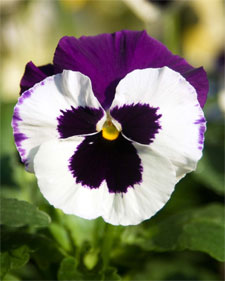Pansy Time in Texas!

They’re the most popular annual flower in Texas. They’re beautiful, they’re easily grown, and there isn’t a lot of competition of plants willing to thrive through our winters. Best of all, there are now hundreds of colors and varieties, so you can achieve almost any look that you want.
Basic tips to success:
• Pansies need full sun and carefully prepared, well-draining soil. Incorporate several inches of organic matter (blend of sphagnum peat moss, pine bark mulch, compost and rotted manure), along with 1 inch of expanded shale, and blend it 10-12 inches into the existing soil. The easiest way to ensure good drainage is to raise their planting beds by 5-6 inches, and mixing that organic matter into the soil will accomplish that.
• Buy vigorous plants in bud and bloom, and checkerboard them 12 inches apart in their beds. Water them as soon as you finish planting them, and apply a high-nitrogen, water-soluble fertilizer as your plant starter. Nitrogen encourages the best growth, even in cool months. Some gardeners prefer blood meal (also all-nitrogen), and that’s fine as well, although it’s much more slowly "available" for uptake by plants’ roots.
• Using one color, or slight variations of a close color family will give the greatest impact within your bed. Mixed pansy plantings don’t show up as well.
• Smaller-flowering pansies produce far more blooms for a much greater overall show in the garden than the compelling large-flowering types will yield.
• Include pansies in your patio pots, too. They’ll survive the winter in most Texas settings without a lot of heroic care, but you’ll need to move them into a protected spot when temperatures drop below 20 or so. The plants may look almost as if they’d been boiled while they’re frozen, but they’re quick to rebound when temperatures rise into the mid-30s. They’re durable little plants to be sure.
• The worst thing that can happen to pansies is to sit in wet soil for several days. If your plants start wilting, and if their stems near the soil line are constricted, you’ve been hit by the group of water-mold funguses that are very damaging to pansies, snapdragons, petunias, periwinkles and mums. You’ll need to avoid those plants for the future. Better yet, prepare the pansy bed to drain well. If you do, odds of the water molds appearing will diminish greatly.

